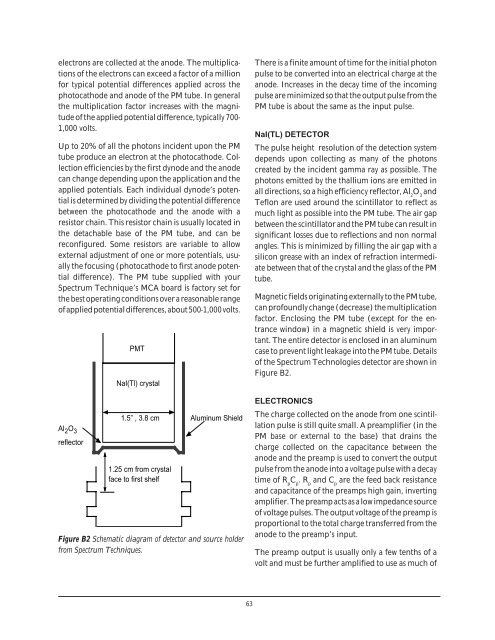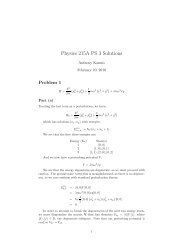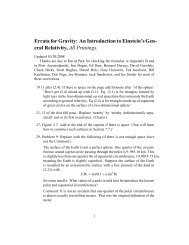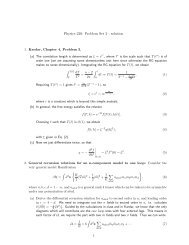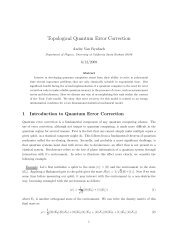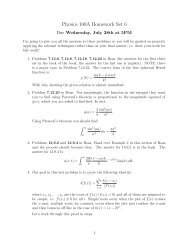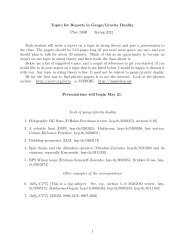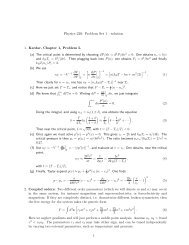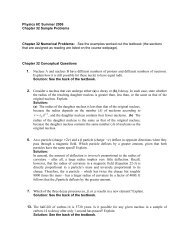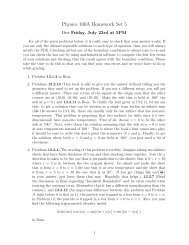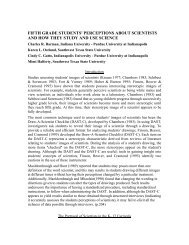Nuclear Spectroscopy
Nuclear Spectroscopy
Nuclear Spectroscopy
You also want an ePaper? Increase the reach of your titles
YUMPU automatically turns print PDFs into web optimized ePapers that Google loves.
electrons are collected at the anode. The multiplications<br />
of the electrons can exceed a factor of a million<br />
for typical potential differences applied across the<br />
photocathode and anode of the PM tube. In general<br />
the multiplication factor increases with the magnitude<br />
of the applied potential difference, typically 700-<br />
1,000 volts.<br />
Up to 20% of all the photons incident upon the PM<br />
tube produce an electron at the photocathode. Collection<br />
efficiencies by the first dynode and the anode<br />
can change depending upon the application and the<br />
applied potentials. Each individual dynode’s potential<br />
is determined by dividing the potential difference<br />
between the photocathode and the anode with a<br />
resistor chain. This resistor chain is usually located in<br />
the detachable base of the PM tube, and can be<br />
reconfigured. Some resistors are variable to allow<br />
external adjustment of one or more potentials, usually<br />
the focusing (photocathode to first anode potential<br />
difference). The PM tube supplied with your<br />
Spectrum Technique’s MCA board is factory set for<br />
the best operating conditions over a reasonable range<br />
of applied potential differences, about 500-1,000 volts.<br />
Al 2 O 3<br />
reflector<br />
PMT<br />
NaI(Tl) crystal<br />
1.5” , 3.8 cm<br />
1.25 cm from crystal<br />
face to first shelf<br />
Aluminum Shield<br />
Figure B2 Schematic diagram of detector and source holder<br />
from Spectrum Techniques.<br />
There is a finite amount of time for the initial photon<br />
pulse to be converted into an electrical charge at the<br />
anode. Increases in the decay time of the incoming<br />
pulse are minimized so that the output pulse from the<br />
PM tube is about the same as the input pulse.<br />
NaI(TL) DETECTOR<br />
The pulse height resolution of the detection system<br />
depends upon collecting as many of the photons<br />
created by the incident gamma ray as possible. The<br />
photons emitted by the thallium ions are emitted in<br />
all directions, so a high efficiency reflector, Al 2<br />
O 3<br />
and<br />
Teflon are used around the scintillator to reflect as<br />
much light as possible into the PM tube. The air gap<br />
between the scintillator and the PM tube can result in<br />
significant losses due to reflections and non normal<br />
angles. This is minimized by filling the air gap with a<br />
silicon grease with an index of refraction intermediate<br />
between that of the crystal and the glass of the PM<br />
tube.<br />
Magnetic fields originating externally to the PM tube,<br />
can profoundly change (decrease) the multiplication<br />
factor. Enclosing the PM tube (except for the entrance<br />
window) in a magnetic shield is very important.<br />
The entire detector is enclosed in an aluminum<br />
case to prevent light leakage into the PM tube. Details<br />
of the Spectrum Technologies detector are shown in<br />
Figure B2.<br />
ELECTRONICS<br />
The charge collected on the anode from one scintillation<br />
pulse is still quite small. A preamplifier (in the<br />
PM base or external to the base) that drains the<br />
charge collected on the capacitance between the<br />
anode and the preamp is used to convert the output<br />
pulse from the anode into a voltage pulse with a decay<br />
time of R p<br />
C p<br />
. R p<br />
and C p<br />
are the feed back resistance<br />
and capacitance of the preamps high gain, inverting<br />
amplifier. The preamp acts as a low impedance source<br />
of voltage pulses. The output voltage of the preamp is<br />
proportional to the total charge transferred from the<br />
anode to the preamp’s input.<br />
The preamp output is usually only a few tenths of a<br />
volt and must be further amplified to use as much of<br />
63


